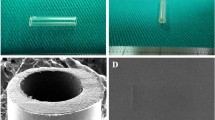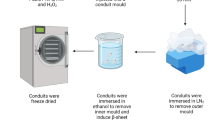Abstract
Conductive polymers show great promise because of their electrical property based on bioelectricity in vivo. In order to search electro-activity materials which insure abduction of tissue, we synthesized conductive nerve conduits with poly-dl-lactic-acid (PDLLA) and tetra-aniline (TA). Preparation technology of TA was optimized, and the properties of the conduit were studied. RSC96 cell were used to investigate the toxicity and electrical stimulation effect. SD rats were used to assess biocompatibility in vivo. The results showed that the reaction ratio of 1:1, the reaction time of 2 h and the HCl concentration of 2 mol/L were the optimum conditions for synthesis of TA. The influence of TA content on the mechanical properties, hydrophilicity, conductivity and microstructure of the nerve conduit was evaluated. Cell and histocompatibility study showed PDLLA/TA possessed good biocompatibility. These results showed it had application values in tissue projects.
Similar content being viewed by others
References
Alberti KA, Neufeld, CI, Wang J, et al. In vivo Peripheral Nerve Repair Using Tendon–Derived Nerve Guidance Conduits[J]. ACS Biomaterials Science & Engineering, 2016, 2(6): 937–945
Evans GR. Peripheral Nerve Injury: A Review and Approach to Ttissue Engineered Constructs[J]. The Anatomical Record, 2001, 263(4): 396–404
Subramanian A, Krishnan UM, Sethuraman S. Development of Biomaterial Scaffold for Nerve Tissue Engineering: Biomaterial Mediated Neural Regeneration[J]. Journal of Biomedical Science, 2009, 16(1): 108
Pires F, Ferreira Q, Rodrigues, et al. Neural Stem Cell Differentiation by Electrical Stimulation Using a Cross–linked PEDOT Substrate: Expanding the Use of Biocompatible Conjugated Conductive Polymers for Neural Tissue Engineering[J]. Biochimica et Biophysica Acta, 2015, 1850(6): 1 158–1 168
Ai J, Kiasat–Dolatabadi A, Ebrahimi–Barough S, et al. Polymeric Scaffolds in Neural Tissue Engineering: A Review[J]. Archives of Neuroscience, 2013, 1(1): 15–20
Ghasemi ML, Prabhakaran MP, Morshed M, et al. Application of Conductive Polymers, Scaffolds and Electrical Stimulation for Nerve Tissue Engineering[J]. Journal of Tissue Engineering and Regenerative Medicine, 2011, 5(4): e17–35
Gomez N, Schmidt CE. Nerve Growth Factor–immobilized Polypyrrole: Bioactive Electrically Conducting Polymer for Enhanced Neurite Extension[J]. Journal of Biomedical Materials Research Part A, 2007, 81(112): 135–149
Bendrea AD, Cianga L, Cianga I. Review Paper: Progress in the Field of Conducting Polymers for Tissue Engineering Applications[J]. Journal of Biomaterials Applications, 2011, 26(1): 3–84
Shirakawa H, Louis EJ, MacDiarmid AG, et al. Synthesis of Electrically Conducting Organic Polymers: Halogen Derivatives of Polyacetylene [J]. Journal of the Chemical Society, Chemical Communications, 1977, 474(16): 578
George PM, Lyckman AW, LaVan DA, et al. Fabrication and Biocompatibility of Polypyrrole Implants Suitable for Neural Prosthetics[J]. Biomaterials, 2005, 26(17): 3 511–3 519
Qazi TH, Rai R, Boccaccini AR. Tissue Engineering of Electrically Responsive Tissues Using Polyaniline Based Polymers: A Review[J]. Biomaterials, 2014, 35(33): 9 068–9 086
Kim DH, Richardson–Burns SM, Hendricks JL, et al. Effect of Immobilized Nerve Growth Factor on Conductive Polymers: Electrical Properties and Cellular Response[J]. Advanced Functional Materials, 2007, 17(1): 79–86
Richardson–Burns SM, Hendricks JL, Martin DC. Electrochemical Polymerization of Conducting Polymers in Living Neural Tissue[J]. Journal of neural engineering, 2007, 4(2): L6–L13
Lee JY, Bashur CA, Goldstein AS, et al. Polypyrrole–coated Electrospun PLGA Nanofibers for Neural Tissue Applications[J]. Biomaterials, 2009, 30(26): 4 325–4 335
Xu H, Holzwarth JM, Yan Y, et al. Conductive PPY/PDLLA Conduit for Peripheral Nerve Regeneration[J]. Biomaterials, 2014, 35(1): 225–235
Li M, Guo Y, Wei Y, et al. Electrospinning Polyaniline Contained Gelatin Nanofibers for Tissue Engineering Applications[J]. Biomaterials, 2006, 27(5): 2 705–2 715
Balint R, Cassidy NJ, Cartmell SH. Conductive Polymers: Towards a Smart Biomaterial for Tissue Engineering[J]. Acta Biomaterialia, 2014, 10(6): 2 341–2 353
Gajendiran M, Choi J, Kim S–J, et al. Conductive Biomaterials for Tissue Engineering Applications[J]. Journal of Industrial and Engineering Chemistry, 2017, 51(86): 12–26
Ji W, Yang F, Seyednejad H, et al. Biocompatibility and Degradation Characteristics of PLGA–based Electrospun Nanofibrous Scaffolds with Nanoapatite Incorporation[J]. Biomaterials, 2012, 33(28):6 604–6 614
Kulszewica–bajer IR, Żalska I, Kurylek M. Synthesis and Spectroscopic Properties of Aniline Tetramers. Comparative studies[J]. New J. Chem., 2004, 28(6): 669–675
Liu S, Zhu K, Zhang Y, et al. Synthesis and Electrical Conductivity of Poly(methacrylamide) (PMAA) with Fixed Length Oligoaniline as Side Chains[J]. Materials Letters, 2005, 59(28): 3 715–3 719
Wang Q, He W, Huang J, et al. Synthesis of Water Soluble, Biodegradable, and Electroactive Polysaccharide Crosslinker with Aldehyde and Carboxylic Groups for Biomedical Applications[J]. Macromolecular bioscience, 2011, 11(3): 362 372
Martina M, Hutmacher DW. Biodegradable Polymers Applied in Tissue Engineering Research: a Review[J]. Polymer International, 2007, 56(2): 145–157
Zhang Z, Rouabhia M, Wang Z, et al. Electrically Conductive Biodegradable Polymer Composite for Nerve Regeneration: Electricity Stimulated Neurite Outgrowth and Axon Regeneration[J]. Artificial Organs, 2007, 31(1): 13–22
Chen L, Yu Y, Mao H, et al. Synthesis of Parent Aniline Tetramer and Pentamer and Redox Properties[J]. Materials Letters, 2005, 59(19–20): 2 446–2 450
Xu H, Yan Y, Li S. PDLLA/chondroitin Sulfate/chitosan/NGF Conduits for Peripheral Nerve Regeneration[J]. Biomaterials, 2011, 32(20): 4 506–4 516
Xu H, Zhang L, Bao Y, et al. Preparation and Characterization of Injectable Chitosan–hyaluronic Acid Hydrogels for Nerve Growth Factor Sustained Release[J]. Journal of Bioactive and Compatible Polymers, 2016, 32(2): 146–162
Abdul RN, Gizdavic–Nikolaidis M, Ray S, et al. Functional Electrospun Nanofibres of Poly(lactic acid) Blends with Polyaniline or Poly(anilineco–benzoic acid)[J]. Synthetic Metals, 2010, 160(17–18): 2 015–2 022
Liu JJ, Wang CY, Wang JG, et al. Peripheral Nerve Regeneration Using Composite Poly(lactic acid–caprolactone)/nerve growth factor Conduits Prepared by Coaxial Electrospinning[J]. Journal of Biomedical Materials Research,Part A, 2011, 96(1): 13–20
Cheng M, Deng J, Yang F, et al. Study on Physical Properties and Nerve Cell Affinity of Composite Films from Chitosan and Gelatin Solutions[J]. Biomaterials, 2003, 24(17): 2 871–2 880
Gómez I, Otazo EM, Hernández H, et al. Thermal Degradation Study of PVA Derivative with Pendant Phenylthione Carbamate Groups by DSC/TGA and GC/MS[J]. Polymer Degradation and Stability, 2015, 112: 132–136
Green RA, Baek S, Poole–Warren LA, et al. Conducting Polymer–hydrogels for Medical Electrode Applications[J]. Science and Technology of Advanced Materials. 2010, 11 (1): 014 107
Wang GW, Yang H, Wu WF, et al. Design and Optimization of a Biodegradable Porous Zein Conduit using Microtubes as a Guide for Rat Sciatic Nerve Defect Repair[J]. Biomaterials, 2017, 131: 145–159
Rao J, Cheng Y, Liu Y, et al. A Multi–walled Silk Fibroin/silk Sericin Nerve Conduit Coated with Poly(lactic–co–glycolic acid) Sheath for Peripheral Nerve Regeneration[J]. Materials science & engineering C, Materials for Biological Applications, 2017, 73: 319–332
Banisadi H, Ramazani S A A, Mashayekhan S. Fabrication and Characterization of Conductive Chitosan/gelatin–based Scaffolds for Nerve Tissue Engineering[J]. Int. J. Biol. Macromol., 2015, 74: 360–366
Author information
Authors and Affiliations
Corresponding authors
Additional information
Funded by the National Natural Science Foundation of China (Nos.51473130 and 51572206), and the Wuhan Huanghe Excellence Plan and Entrepreneurship Training Program of Wuhan University of Technology (Nos.20181049715010 and 20181049715018)
Rights and permissions
About this article
Cite this article
Guo, X., Liu, G., He, Q. et al. The Study of Nerve Conduit with Biocompatibility and Electrical Stimulation Effect. J. Wuhan Univ. Technol.-Mat. Sci. Edit. 33, 1530–1539 (2018). https://doi.org/10.1007/s11595-018-2002-x
Received:
Accepted:
Published:
Issue Date:
DOI: https://doi.org/10.1007/s11595-018-2002-x




